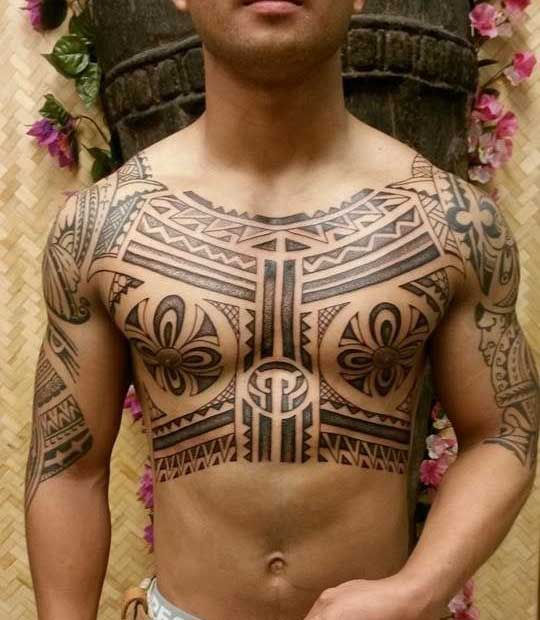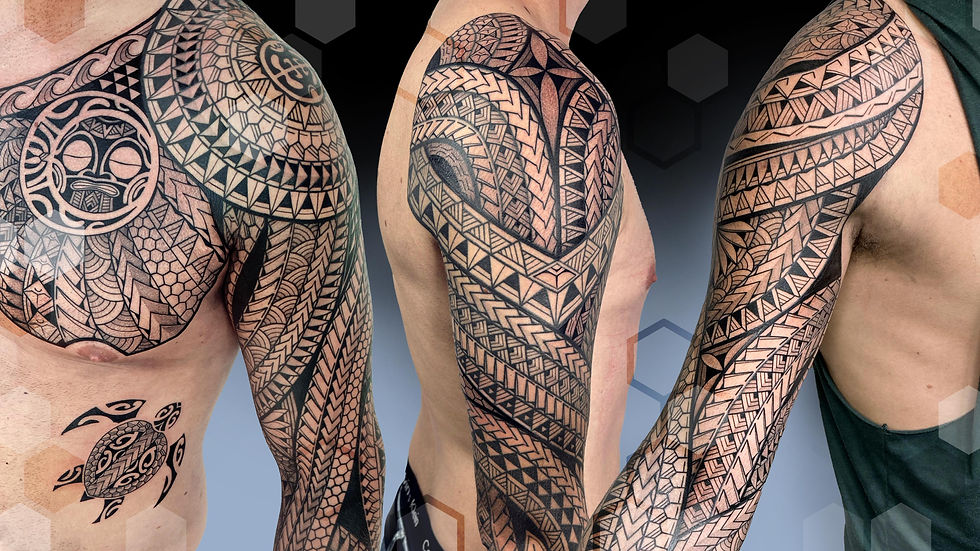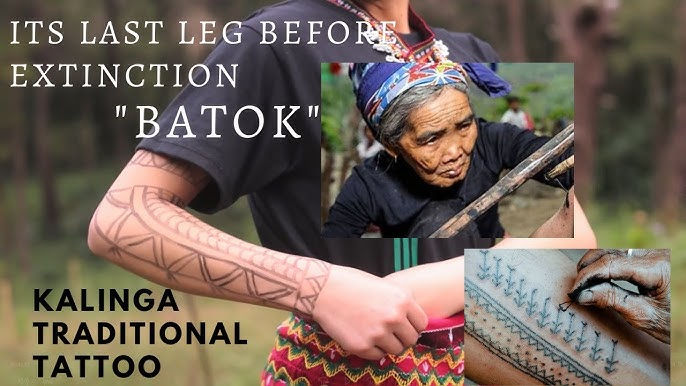The Rise of Filipino Tribal Tattoos in Toronto: Culture, Identity, and the Hon Tattoo Studio Experience
- hontattoostudio
- Sep 29
- 5 min read
Did you know tattoos in the Philippines predate modern machines by centuries?
When most people think of tribal tattoos, their minds often jump to Polynesian or Maori traditions. But the Philippines has a tattoo heritage just as rich, deeply spiritual, and visually striking. At Hon Tattoo Studio in Toronto, our newest Filipino artist is bringing this heritage to life—sharing ancient designs, reinterpreted for modern skin.
For clients, this means access to authentic Filipino tribal tattoos, alongside other world-renowned tribal styles. For the artist, it is a mission: to preserve, share, and celebrate cultural identity through ink.

A Deep History: Filipino Tribal Tattoos
Before Spanish colonisation, tattooing in the Philippines was widespread, particularly among the Visayan and Cordilleran peoples. Tattoos, known as “batok”, were not simply decoration—they carried profound meanings.
Markers of Courage: Warriors earned tattoos as records of bravery in battle.
Symbols of Belonging: Tattoos reflected lineage, community, and tribal identity.
Spiritual Protection: Many believed tattoos offered divine guardianship.
Unlike modern flash sheets, Filipino tribal tattoos were often hand-tapped, using natural tools like thorn needles and soot-based ink. The process was as spiritual as the final artwork—tattoos were rites of passage, ceremonies of identity.

Polynesian, Maori, and Filipino Tattoos: Shared Roots, Distinct Voices
At first glance, tribal tattoos from the Pacific and Southeast Asia may appear similar—geometric shapes, bold lines, repeating motifs. Yet each tradition carries distinct cultural DNA.

Polynesian Tattoos
Focus heavily on oceanic elements (waves, fish hooks, turtles).
Often covers large parts of the body with continuous flow.
Serve as genealogical records, mapping lineage and ancestry.

Maori Tattoos (Ta Moko)
Feature spiral and curve motifs unique to Maori carving styles.
Often tattooed on the face, representing social rank and personal history.
Traditionally chiselled into the skin, leaving textured grooves.

Filipino Tattoos (Batok)
Distinguished by linear, repeating geometric patterns (diamonds, triangles, zigzags).
More minimalist and sharp compared to Polynesian curves.
Represent bravery, belonging, and spirituality, especially in Cordillera and Visayan traditions.
👉 The difference lies not only in appearance but in cultural function. While all three traditions honour ancestry and identity, Filipino tattoos often emphasize communal belonging and spiritual guardianship.
Why Filipino Tribal Tattoos Deserve the Spotlight
In the global tattoo conversation, Polynesian and Maori tattoos often dominate. But Filipino tattoos are experiencing a revival, thanks to diaspora artists who are reconnecting with their roots.
Unique Aesthetic: Their sharp geometry stands out in a world full of curved motifs.
Cultural Reclamation: For many Filipinos abroad, getting tribal tattoos is an act of reconnecting with heritage.
Timeless Symbolism: Courage, community, protection—values that resonate across cultures and generations.
At Hon Tattoo Studio, our new Filipino artist isn’t just tattooing skin—he’s reviving a legacy, one design at a time.
The Artist’s Mission: Sharing Filipino Identity in Toronto
Our Filipino artist joined Hon Tattoo Studio not only as a craftsman but as a cultural ambassador. His mission is twofold:
To Educate: Many clients don’t know that the Philippines’ tattoo heritage exists. He shares stories, explains symbolism, and connects art to identity.
To Preserve: By practising these designs in Toronto, he ensures traditions survive beyond borders.
His passion is evident in every piece. Whether it’s a small arm band or a full chest design, he treats each tattoo as a sacred act of storytelling.

Why Clients in Toronto Are Drawn to Tribal Tattoos
Toronto’s multicultural population is uniquely receptive to global tattoo traditions.
Filipino diaspora clients seek tattoos as a way to honour their heritage.
Non-Filipino clients are fascinated by the bold simplicity of tribal motifs and the cultural depth behind them.
Tattoo enthusiasts appreciate the artistry and discipline required to create repeating geometric patterns by hand.
Tribal tattoos in Toronto aren’t just trends—they’re bridges between cultures, carried on skin.
Hon Tattoo Studio: A Hub for Cultural Tattoo Artistry
By welcoming a Filipino tribal specialist into our team @J.inkszz_tt, Hon Tattoo Studio strengthens its role as a global tattoo hub in Toronto.
Our studio and @J.inkszz_tt, now offers:
Authentic Filipino batok patterns, reinterpreted for modern tattoo machines or hand-poked styles.
Comparative artistry, allowing clients to explore Polynesian, Maori, and Filipino motifs side by side.
Cultural respect: We don’t treat tribal tattoos as fashion. We honour their roots, educate clients, and approach them with integrity.
For us, bringing in global artists is not just about variety—it’s about preserving traditions while making them accessible in respectful, authentic ways.
Client Stories
Case 1: Reconnecting With Roots
A Filipino-Canadian client came to us wanting to honour her grandmother’s lineage from the Cordillera region. Our artist designed a geometric arm band using traditional patterns. The client said:
“I feel like I’m carrying my ancestors with me now.”
Case 2: Curiosity Beyond Culture
A non-Filipino client, fascinated by Polynesian art, discovered Filipino batok during a consultation. He chose a chest piece blending Filipino diamonds with Polynesian waves, symbolizing unity between cultures.
Case 3: A Modern Warrior Mark
A young professional wanted a tattoo representing resilience in his career. Our artist created a Filipino-inspired chest tattoo symbolizing bravery and forward motion.

FAQs: Filipino Tribal Tattoos in Toronto
1. Are Filipino tribal tattoos different from Polynesian or Maori tattoos?
Yes. Filipino tattoos are more geometric and linear, while Polynesian and Maori styles emphasise curves, spirals, and continuous flow.
2. Do tribal tattoos always have cultural meaning?
Traditionally, yes. Modern clients often choose them for heritage, identity, or symbolic protection.
3. Can non-Filipinos get Filipino tribal tattoos?
Yes, but with respect. Our artist takes time to explain cultural significance so tattoos are chosen thoughtfully.
4. Are Filipino tattoos done by hand-tapping?
Traditionally, yes. At Hon Tattoo Studio, clients can choose modern machine application or hand-poked methods inspired by traditional practices.
5. Why get a tribal tattoo at Hon Tattoo Studio?
Because our artist isn’t just replicating designs—he’s reviving tradition with authenticity, artistry, and cultural respect.
Carrying Culture Through Ink
Tattoo culture thrives when it carries more than aesthetics—it carries stories, ancestry, and spirit. Filipino tribal tattoos represent bravery, community, and resilience, values that resonate deeply in Toronto’s diverse landscape.
At Hon Tattoo Studio, we’re proud to provide a space where clients can experience these traditions first-hand, guided by an artist dedicated to sharing his heritage.
👉 Whether you’re Filipino seeking reconnection, or a tattoo lover seeking bold cultural artistry, our studio offers more than tattoos—it offers a journey into living heritage.
📍 Visit Us
202 Queen St W (Downtown Toronto, 2nd Floor) – 📞 (437) 533-7749
6293 Yonge St (North York) – 📞 (905) 604-5102
9671 Jane St Unit 4 (Vaughan) – 📞 (416) 728-8922
🌐 Website: hontattoo.com
📸 Instagram: @hontattoostudio
Or by clicking the button below, you can ask us any questions you might have have about tattoos


